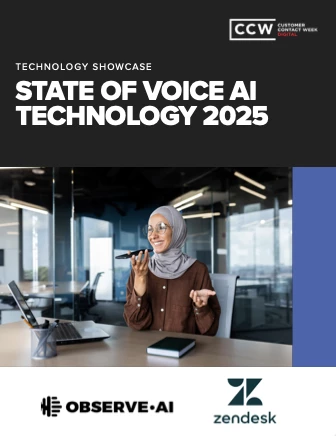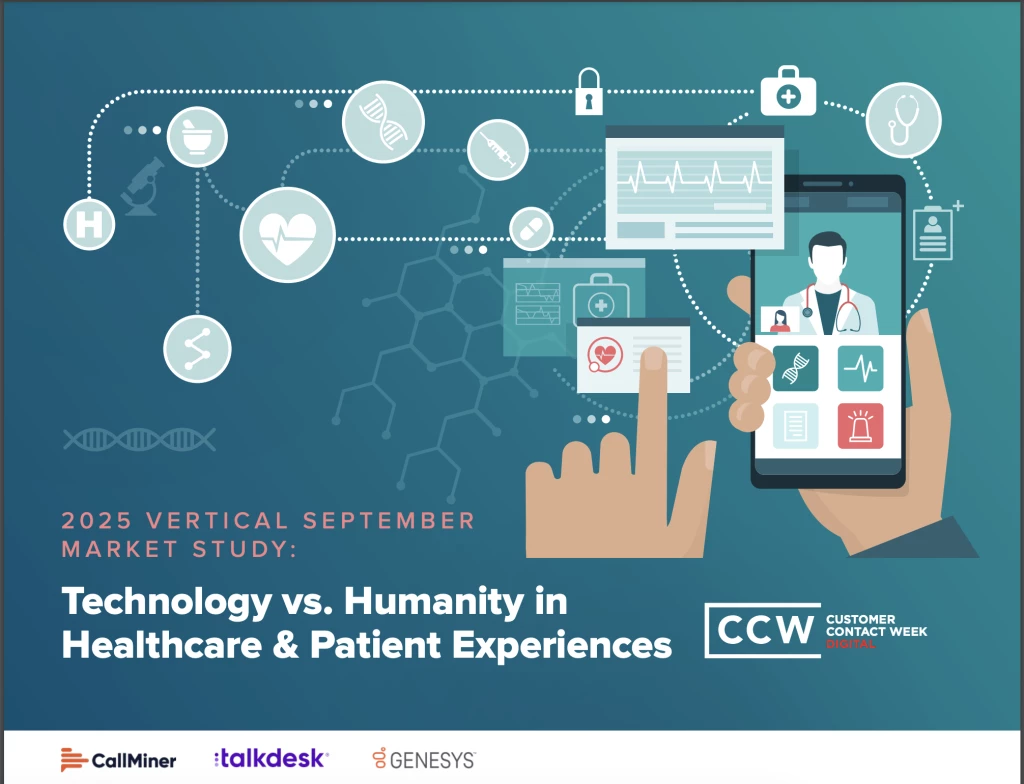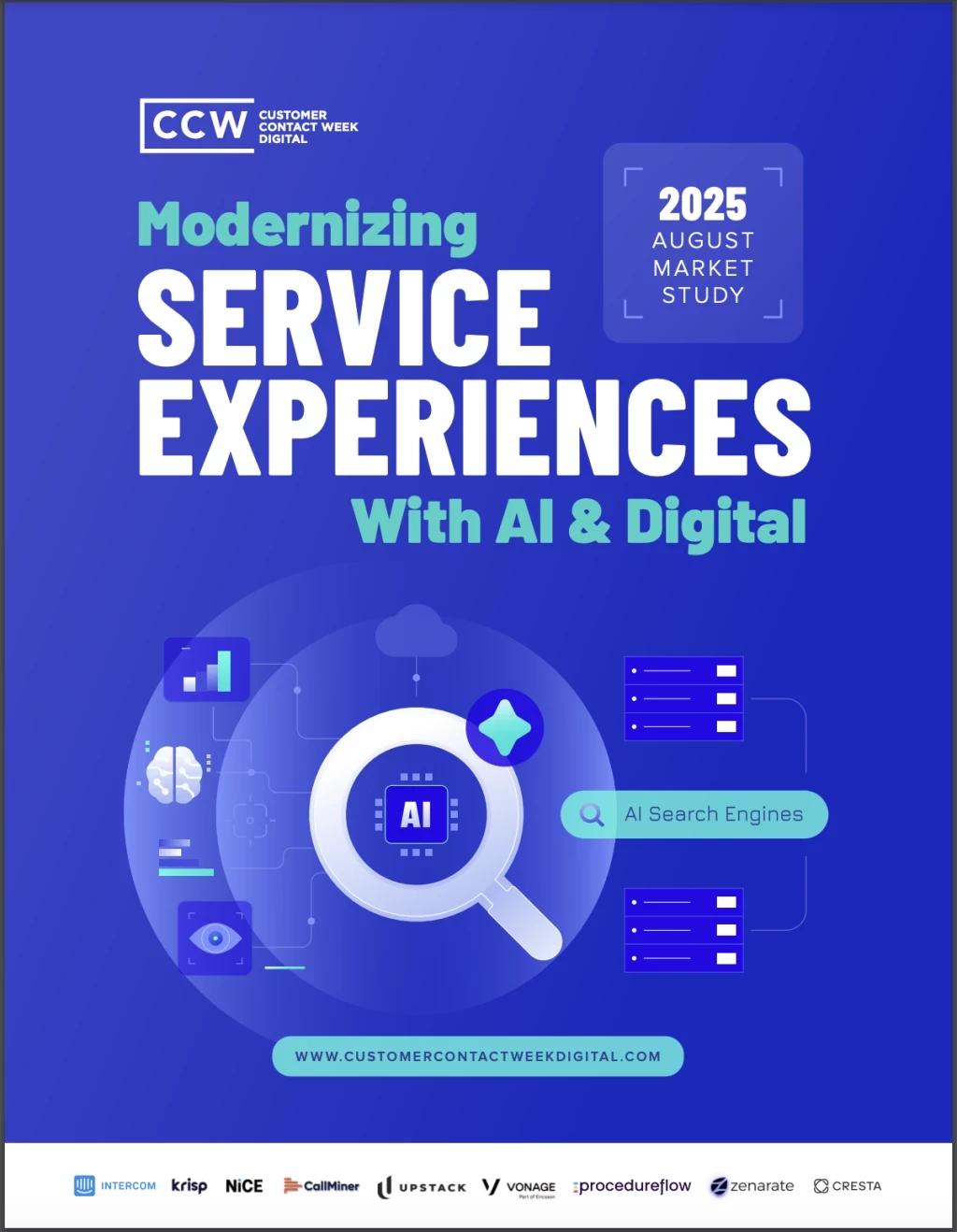The AI-Savvy Agent of the Future: How To Prepare Your Workforce For Digital Success
The future of CX is customer-first and tech-focused. Agents will need to be ready for it.
Add bookmark
Organizations want to establish themselves as innovative influencers in the CX space, but are struggling to do so. Despite best efforts to modernize the contact center, the omnichannel tools agents are using right now are not setting them up for success in real-time, or in the future. In order to change that dynamic, contact centers need to invest more time into aligning trending tech like Gen AI with agents’ needs in the workplace. As a united front, organizations can re-engineer their CX framework and come out the other end with a system that works for, evolves with and supports organizational goals.
Because the future of CX is customer-first and technology-focused, agents will need to have not just the knowledge, but the skills necessary to navigate interactions in more efficient ways. As tools like Generative AI grow in popularity, contact center employees will need to stay sharp in order to keep up with consumer demands and CX trends. However, adapting to digital transformation requires not just dedication from employees, but determination from contact center leaders to provide the guidance and framework necessary to prime the agent of today into the agent of the future.
As Digital Capabilities Expand, Agents Are Unsure Of Their Place In The CX Ecosystem
Contact centers want not to just be modernized, but on the up-and-up of trending CX technology to stay relevant, attract high performers, and ultimately gain loyal customers who trust their brand experiences across the board.
Looking towards the future, organizations need to make a dedicated effort to build the type of contact center that yields those specific results. Further, they must ensure their frontline is able to thrive in these conditions. The contact center of the future, then, must employ agents who are capable and confident in not just using advanced tech tools as they stand right now, but leading the charge on digital transformation as those tools evolve.
Despite wanting this outcome, it’s clear that CX teams are not quite on board yet. Right now, it’s difficult for agents to determine where they fit into the digital landscape, especially after Generative AI entered the CX space. Gen AI is impacting messaging, email, and voice in the contact center. For the agent this change in dynamic can be daunting–many areas of their workflow, which they used to be personally responsible for, are being automated.
Omnichannel May Be The Goal, But Contact Centers Still Struggle To Manage Productivity
In the age of Generative AI agents are still managing too many screens, parsing through customer data, and engaging with highly frustrated customers. Ideally, digital CX tools should be minimizing sources of agent overwhelm. Instead, their mere presence in the contact center can become largely overwhelming.
To establish them as a value-add, contact centers face some struggles: many digital options in the contact center mirror one another. At times, there is no clear delineation on how each option and channel is differentiated or how it will impact employee workflows and experiences.
When agents lack direction on how they should use these tools–or how customers use them–they spend valuable time troubleshooting their own workflows instead of offering solutions to customers. The “digital disconnect” is amplified when employees looking to forge their own path are paralyzed by the number of omnichannel options available.
While these new additions to contact center workflows are intended to simplify and streamline EX, their initial reception and impact in the contact center may not be as immediate. Introducing, training, and engaging employees on new technology takes notable time–anywhere from 6 to 24 months.
In the interim, employees can lose momentum or even desire to dive into the future of digital. CCW Digital research confirms this notion: 61% of contact center leaders believe a lack of employee buy-in inhibits their ability to train team members. If agents do not feel immersed enough in the business vision–and see their place in it–they will pull back.
Gen AI Gives Employees Bigger Bandwidth, But Might Not Come with Better Compensation
As we’ve already discussed, Gen AI can support agents in organizing data, summarizing calls, and allowing customers to self-serve on smaller issues. Once unencumbered by these tasks, agents will widen their scope of availability and take on more complex work.
Upon closer analysis, the complexity of this work ranges from resolving issues customers were unable to address via self-service, dedicating time towards those consumers who prefer agent-led experiences or 1-on-1 support, and collaborating with and training coworkers on new technologies and workflows.
Managers investing funds, and people-power into Gen AI want agents to be more available and equipped for navigating interactions with greater emotional gravitas. By using Gen AI in the contact center to inform customer interactions, agents' abilities to anticipate needs, understand context and provide support advance exponentially.
However, these tech improvements, while a finance and time management-savvy move for the C Suite, might not mean higher pay for agents who have learned how to use platforms. As they begin to engage interpersonally with customers, agents are taking on a greater workload that they yet might not be compensated for.
As agents’ competencies and responsibilities increase, but their opportunities to rise the CX ranks do not. As the customer service landscape becomes increasingly more competitive, leaders are torn between investing in digital and investing in the future of their employees.
The reality of customer contact today is that investing in agent tools may not be enough; the future of the agent experience entails more complex, involved and potentially emotional work–this bump in responsibilities now needs to coincide with a bump in compensation. If not, organizations may struggle with attrition and imminent turnover.
Agents Are Armed With “Advanced Tech,” But Pinned Down By Way-Back-When Policies
Even though agents may have the technology they need to address more “complex” issues, the C Suite still might not let that happen: 82% of contact center leaders offer agents minimal freedom to go “above and beyond” when issuing make-goods and compensation to customers, despite the multitude of tools at their fingertips that can help them do it with expert precision.
We’re all familiar with these policies–limited return times, no exchanges, no refunds, and make-goods that don’t make the agent look all that good when they offer them. Just 6% of contact center leaders grant agents complete autonomy to make their own off-script decisions. In decades past, these policies reflected the state of customer service, but in 2024 they are becoming a point of contention.
Customers expect–and demand–more from brands, and companies are faced with the challenge of modernizing their policies while also protecting their employees and product revenue. However, in the digital age, providing memorable experiences requires thinking outside the box and creativity. With so many more channels to engage and opportunities to connect with customers, there are multiple means by which today’s customer/agent interactions can lead to circumstances that require a bend of the rules of old.
This is why leaders must understand that the next steps to the ‘“next-generation agent” may require a shift in these defined policies. Flexibility and agency for the customer can ultimately lead to long-term loyalty because strict policies can and will get in the way. Understanding the opportunity cost will be essential moving forward.
Laying The Groundwork For The Agent Of The Future: Next Steps
Agents Feeling Out Of Sync With CX? Do An Omnichannel Audit And Fine-Tune Your Technology
Forty-nine percent of contact center leaders believe their agents are already eager to take on more complex work; 40% feel that willingness is conditional upon receiving better compensation and/or career opportunities. If agents are feeling disconnected from their workflow and knowledge management tools, contact center leaders ought to prioritize bringing them into the decision and implementation process.
Invite your agents to walk you through their side of the customer journey, and incorporate Gen AI into this review process. Have your agents use the technology to identify some of the exact pain points they experience–can they go through the platform and pull up a moment where a customer interaction was tense and they didn’t have the knowledge necessary to resolve it with ease?
Was there a moment where Gen AI helped them address an issue with ease, or that it lengthened their process? Collaboration on this end will allow agents to have agency and involvement on two fronts: their data is central to the digital discussion, and they get to grease their AI-wheels in a way that shows them the benefits first hand.
Get Curious About Your Team
Ask their opinion on new CX tech trends that they see competitors, contemporaries and current events they are focusing on. Encourage them to identify which they want to know more about and which tools they don’t don’t see as essential. In the event that some employees are shy to provide feedback, allow the opt-in for anonymous polling or forms.
After soliciting feedback, take it in earnest and see how it can be applied to current systems, workflows and operations. Start with what tools and platforms you have at your disposal, before feeling compelled to reinvent the wheel. If it turns out that agents require other tools or capabilities that are not currently available in the contact center, devise a plan of action on how your organization can practically make that amendment.
Moreover, having consistent conversations or think tanks on the state of Generatie AI at large will allow managers and agents alike to become familiar with terms and technologies, while observing in real-time what industry standards are and where Gen AI is falling flat for agents. Allowing agents to research and demo different Gen AI CX options and provide feedback on what works for them in terms of knowledge management and agent assist can also aid them in gaining ownership of experiences.
In turn, agents will feel seen, heard, and emotionally valued in the contact center beyond their collaboration with technology, creating a strengthened contact center culture. Provided your brand follows-through with enacting these changes, agent trust in management and their commitment to providing quality service will be renewed.
Potential Challenges And Pitfalls
When facing roadblocks, having challenges or sitting on innovative ideas, they’ll be more prone to share and be proactive, knowing they have full organizational support. Instead of feeling limited by busy work or distracted by jumping through hoops, they instead will have a clear vision of what to expect now, and a defined pathway leading to their future in the contact center.
Identifying career pathing that both reflects future expectations for agents and acknowledges the strides they’re making in the current tech landscape. This will ultimately strengthen the contact center at its core.
Now that you’ll know how the agent workflow has changed, improved, or gotten more difficult since introducing Gen AI and omnichannel tools into the contact center, you can analyze where successes, pitfalls, and areas for agent improvement exist for your team. What’s better–you can even use Gen AI to dive deeper into these metrics. Compare what EX would be with or without these tools, and map out those trajectories with the input of your agents to get a full view of what the workforce looks like.
Create a new framework that both leverages and incentivizes focus on Gen AI in employee workflows, and allows agents to have agency in the process:
- What can they teach their teammates/managers?
- How can they help customers navigate digital and Gen AI in self service
- In what ways do they inform the AI knowledge base?
- How can KPIs, title changes, pay rates, and promotions reflect those efforts?
With each step, agents will grow to understand the value add, flexibility and bandwidth that Gen AI can have in their workflows, and use it to their advantage with customers. When those customer interactions become more organic, succinct and compact thanks to Gen AI’s support in helping the agent better know their customer, then agents are going to be able to turn their attention elsewhere–including inward. More time to strategize will also mean more opportunities to involve their teammates in the CX process. Together, employees can even spearhead new initiatives because of the confidence that has been created through having ownership of their EX and career pathing.
Policies Just Not Cutting It? Review And Readjust To Reflect Tech Capabilities, Contact Center Limitations And Consumer Expectations
As mentioned, agents do not necessarily have the flexibility or autonomy to actually deliver on the next-generation agent capabilities. With strict policies in place, organizations are literally preventing agents from going above and beyond for the customer.
These rigid policies also trickle down to the customer experience. The hassle associated with the transaction process can even lead customers to keep products and take the loss over engaging with a brand.
Understanding what about your current customer service policies are blocking your agents from providing more solutions and finding more resolutions and engaging authentically with customers will be critical moving forward.
Do you think you know the answers based on what you observe in the contact center, or do you know the answers because you invite, listen to and engage with employee feedback?
During their “best” customer interactions and during their “worst,” agents may have a wishlist of things they would have done differently–given the discount, brought in a manager, read up on the customer complaint in more detail before hopping on the line. Whatever that wish may be, contact center leaders should be able to identify and address when some of these wish list items appear regularly on an agent’s list.
Understanding The Customer’s POV
If an agent has a wishlist, the customer certainly has one that’s as long as a CVS receipt. Eighty-three percent of contact leaders anticipate that digital will become the preferred option for basic transactions, and 93% believe that digital will be able to address more complex consumer requests (including initiating returns, resetting passwords, updating account information, and making payments) within the next twelve months. In order to look ahead and prepare agents for the future, getting customer feedback on what aspects of your current policies are blocking CX success when looking for resolutions in digital is key.
Similar to managing feedback with agents, the effort can be a simple Google form, an invite-only Zoom discussion or focus group with the most digital-adept customers, or a post-call customer service survey.
Upon review, how many of these things listed by customers, if changed, would be a financial risk or a company culture shift? If the suggestions appear to be applicable and fall in line with agent concerns and C Suite observations, collaboratively devising a rollout plan to make these changes is the best next step.
When building out these shifts, be sure to create time and space internally and externally for their adoption. Give agents time to get acclimated to them so they don’t fall back onto old policies by habit, and figure out first-hand what tools and tech they need or don’t need to make those solutions a reality.
After a set timeframe, review and revisit these new implementations with data and results:
- Were there hiccups or contingency plans created to support agents or calm down an angry customer?
- Do agents feel more empowered, happier in their work, less stressed or more supported in their roles now that they have this freedom?
- Is your organization seeing tangible results or data that reflects improvements and maybe even leave some wiggle room for investing in new tech down the line?
Fine-tuning this process will take time, but will yield lasting results within the contact center. From the business perspective, leaders can now focus on more forward-thinking instead of stepping in because an agent needs to consult with them on issues.
With the employee experience, agents will be empowered to trust in themselves and their team to support them in their decision making.
And with the customer expectations will not be just leveled, but positively increased and bolstered by trust. Now that customers know that the brand they engage with will provide a seamless digital experience, whether it’s with a chatbot or an agent, they will be confident in every interaction moving forward.
In the end, the agent of the future may not get here today, but organizations can start laying the framework for a tech-savvy, empowered workforce now. Strategic planning surrounding Gen AI tools, and consideration of customer expectations when implementing new technology will ensure that your brand stays steps ahead.































